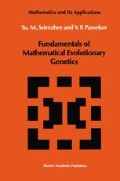Abstract
By the genetic drift, or more strictly, by the random genetic drift in the narrow sense one usually means a random process of variation in gamete concentrations due to the effects of sampling alone at the change of the generations. Initially, the biologist who had paid attention to this phenomenon stressed the important role the drift played in reaching the genetic homogeneity under considerable variations in the population size (causing cancellation of some genetic variants when the size decreases), or under the presence of rare genes (which may happen to be absent in the next generation by pure chance). The situation is however the same when the population size is constant and the gene concentrations are arbitrary in the population.
Access this chapter
Tax calculation will be finalised at checkout
Purchases are for personal use only
Preview
Unable to display preview. Download preview PDF.
Notes and Bibliography
Fisher R.A.: 1922, On the dominance ratio, Proc. Roy. Soc. Edinb. 42,.321–341.
Fisher R.A: 1930, The Genetical Theory of Natural Selection. Oxford: Clarendon Press.
Malyutov, M.B. and Passekov, V.P.: 1971, On the Reconstruction of the Genealogical Tree of Isolated Populations. Interdept. Laboratory of Statistical Methods, Moscow State University, preprint No. 19, 52 pp. (in Russian, with English summary).
Malyutov, M., Passekov, V., and Rychkov, Yu.: 1972, On the reconstruction of evolutionary trees of human populations resulting from random genetic drift. In: Weiner, J.S., and J. Huizinga (eds.), The Assesment of Population Affinities in Man. Clarendon Press, Oxford, pp. 48–71.
Glass B., Sacks M., Jahn E., and Hess C.: 1952, Genetic drift in a religious isolate: an analysis of the causes of variation in blood group and other gene frequencies in small populations, Amer. Natur. 86, No. 828, pp. 145–159.
Passekov, V.P.: 1978, Rodstvo i geneticheskaya blizost populyatsij (Kinship and genetical similarity of populations). Itogi Nauki i Techniki, VINITI, USSR Acad. Sci., Moscow, ‘Mathematical Biology and Medicine’ Series, Vol. 1, pp. 166–209 (in Russian).
Kimura M.: 1955, Random genetic drift in multi-allelic locus, Evolution 9, No. 4, 419–435.
Littler, R.A and Good, AJ.: 1978, Ages, extinction times and first passage probabilities for a multi-allele diffusion model with irreversible mutation, Theor. Pop. Biol. 13, No. 2, 214–225.
Malinovsky, A.A.: 1947, Biologicheskie i sotsialnye faktory v proiskhozhdenii rasovykh razlichiy u cheloveka. (Biological and social factors of racial differentiation in man). Priroda, No. 7, pp. 40–48 (in Russian).
Passekov, V.P.: 1974, Zamechaine otnositelno opredeleniya pervykh momentov vremeni dostizhenii nejtralnogo lokusa (A note on derivation of first moments for the homozygosity attainment time at a neutral locus of a finite population), — Genetika, 10, No. 2, pp. 162–170 (in Russian).
Littler, R.A.: 1975, Loss of variability at one locus in a finite population, — Math. Biosci. 25, N. 1–2, pp. 151–163.
Passekov V.P.: 1978, Srednee vremya uteri allelej v resultate gennogo dreifa v konechnoj populatsii (The mean alleles loss time in the genetic drift process in a finite population). In: Doklady MOIP. Obscaya biologiya, 1976. Sektsiya antropologii, biofiziki, vitaminologii, genetiki, gerontologii, gistologii i embriologii, istorii estestvoznaniya, Komissiya po primeneniyu matematiki v biologii Moskovskogo obsciestva isptatelei prirody (MOIP Reports. General Biology, 1976. Sections of Anthropology, Biophysics, Vitaminology, Genetics, Histology and Embryology, and Natural Sciences History, Commission on Application of Mathematics in Biology of the Moscow Society of Naturalists).Moscow State University, pp. 218–220 (in Russian)
Maruyama, T.: 1974, The age of an allele in a finite population, Genetical Res. 23, No. 2, pp. 137–143.
Passekov V.P.: 1975, Odin podkhod k issledovaniju protsessov diffuzii v genetike (An approach to the investigation of diffusion processes in genetics), Interdept. Laboratory of Statistical Methods, Moscow State University (Moscow, USSR), 49, pp. 63–68 (in Russian).
Kimura M.: 1955, Solution of a process of random genetic drift with a continuous model, Proc. Nat. Acad. Sci. U.S.A, 41, No. 3, pp. 144–150.
Littler R.A. and Fackerell E.D.: 1975, Transition densities for neutral multi-allele diffusion models.Biometrics, 31, No. 1, pp. 117–123.
Griffiths R.C.: 1979, A transition density expansion for a multi-allele diffusion model, Adv. Appl. Probab. 11, No. 2, pp. 310–325.
Ohta T.: 1974, Linkage disequilibrium and associative overdominance due to random genetic drift, Japanese J. Genetics, 46, No. 3, pp. 195–206.
Author information
Authors and Affiliations
Rights and permissions
Copyright information
© 1990 Kluwer Academic Publishers
About this chapter
Cite this chapter
Svirezhev, Y.M., Passekov, V.P. (1990). Random Genetic Drift in the Narrow Sense. In: Fundamentals of Mathematical Evolutionary Genetics. Mathematics and Its Applications, vol 22. Springer, Dordrecht. https://doi.org/10.1007/978-94-009-2589-2_11
Download citation
DOI: https://doi.org/10.1007/978-94-009-2589-2_11
Publisher Name: Springer, Dordrecht
Print ISBN: 978-94-010-7670-8
Online ISBN: 978-94-009-2589-2
eBook Packages: Springer Book Archive

